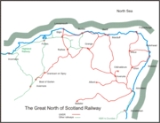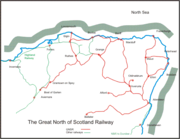
Great North of Scotland Railway
Encyclopedia
The Great North of Scotland Railway (GNSR/GNoSR) was one of the smaller Scottish railways before the grouping
, operating in the far north-east of the country. It was formed in 1845 and received its Parliamentary
approval on June 26, 1846, following over two years of local meetings. In 1923 it was absorbed into the London and North Eastern Railway
as its Northern Scottish area.
 The GNSR's eventual area encompassed the three Scottish
The GNSR's eventual area encompassed the three Scottish
counties of Aberdeenshire
, Banffshire
and Moray
, with short lengths of line in Inverness-shire
and Kincardineshire
. The railway operated its main line between Aberdeen Waterloo and Keith
. Although the line had several branches its remoteness has resulted in only its main line remaining today.
There were connections westward with the Highland Railway
at , , Keith and and southward with the Caledonian Railway
and North British Railway
at Aberdeen, where the three shared a station.
The headquarters were at 89 Guild Street in Aberdeen
and the works at Inverurie
. In 1921 the railway comprised 334 miles of line and the company’s capital was £7 million.
The company also owned hotels in some of the towns and resorts served by its stations. In the early 20th century it also developed a network of feeder bus services.
Chief Mechanical Engineer
Railways Act 1921
The Railways Act 1921, also known as the Grouping Act, was an enactment by the British government of David Lloyd George intended to stem the losses being made by many of the country's 120 railway companies, move the railways away from internal competition, and to retain some of the benefits which...
, operating in the far north-east of the country. It was formed in 1845 and received its Parliamentary
Parliament of the United Kingdom
The Parliament of the United Kingdom of Great Britain and Northern Ireland is the supreme legislative body in the United Kingdom, British Crown dependencies and British overseas territories, located in London...
approval on June 26, 1846, following over two years of local meetings. In 1923 it was absorbed into the London and North Eastern Railway
London and North Eastern Railway
The London and North Eastern Railway was the second-largest of the "Big Four" railway companies created by the Railways Act 1921 in Britain...
as its Northern Scottish area.
Extent

Scotland
Scotland is a country that is part of the United Kingdom. Occupying the northern third of the island of Great Britain, it shares a border with England to the south and is bounded by the North Sea to the east, the Atlantic Ocean to the north and west, and the North Channel and Irish Sea to the...
counties of Aberdeenshire
Aberdeenshire
Aberdeenshire is one of the 32 unitary council areas in Scotland and a lieutenancy area.The present day Aberdeenshire council area does not include the City of Aberdeen, now a separate council area, from which its name derives. Together, the modern council area and the city formed historic...
, Banffshire
Banffshire
The County of Banff is a registration county for property, and Banffshire is a Lieutenancy area of Scotland.The County of Banff, also known as Banffshire, was a local government county of Scotland with its own county council between 1890 and 1975. The county town was Banff although the largest...
and Moray
County of Moray
Moray is one of the registration counties of Scotland, bordering Nairnshire to the west, Inverness-shire to the south, and Banffshire to the east...
, with short lengths of line in Inverness-shire
Inverness-shire
The County of Inverness or Inverness-shire was a general purpose county of Scotland, with the burgh of Inverness as the county town, until 1975, when, under the Local Government Act 1973, the county area was divided between the two-tier Highland region and the unitary Western Isles. The Highland...
and Kincardineshire
Kincardineshire
The County of Kincardine, also known as Kincardineshire or The Mearns was a local government county on the coast of northeast Scotland...
. The railway operated its main line between Aberdeen Waterloo and Keith
Keith railway station
Keith railway station is a railway station serving the town of Keith, Moray, Scotland. The station is managed by First ScotRail and is on the Aberdeen to Inverness Line.-History:...
. Although the line had several branches its remoteness has resulted in only its main line remaining today.
There were connections westward with the Highland Railway
Highland Railway
The Highland Railway was one of the smaller British railways before the Railways Act 1921; it operated north of Perth railway station in Scotland and served the farthest north of Britain...
at , , Keith and and southward with the Caledonian Railway
Caledonian Railway
The Caledonian Railway was a major Scottish railway company. It was formed in the early 19th century and it was absorbed almost a century later into the London, Midland and Scottish Railway, in the 1923 railway grouping, by means of the Railways Act 1921...
and North British Railway
North British Railway
The North British Railway was a Scottish railway company that was absorbed into the London and North Eastern Railway at the Grouping in 1923.-History:...
at Aberdeen, where the three shared a station.
The headquarters were at 89 Guild Street in Aberdeen
Aberdeen
Aberdeen is Scotland's third most populous city, one of Scotland's 32 local government council areas and the United Kingdom's 25th most populous city, with an official population estimate of ....
and the works at Inverurie
Inverurie Locomotive Works
Inverurie Locomotive Works was built in 1903 by the Great North of Scotland Railway in Inverurie, Aberdeenshire, Scotland.- History :The Great North of Scotland Railway constructed its locomotive construction and repair works on a site at Inverurie north west of Aberdeen, adjoining the line to...
. In 1921 the railway comprised 334 miles of line and the company’s capital was £7 million.
The company also owned hotels in some of the towns and resorts served by its stations. In the early 20th century it also developed a network of feeder bus services.
Chief Mechanical EngineerChief Mechanical EngineerChief Mechanical Engineer and Locomotive Superintendent are titles applied by British, Australian, and New Zealand railway companies to the person ultimately responsible to the board of the company for the building and maintaining of the locomotives and rolling stock...
s
- D. K. Clark 1853-1855
- J. F. Ruthven 1855-1857
- W. Cowan 1857-1883
- James Manson 1883-1890
- James Johnson 1890-1894
- William PickersgillWilliam PickersgillWilliam Pickersgill was born in Nantwich in 1861 and died in Bournemouth on 2 May 1928. He was Chief Mechanical Engineer of the Caledonian Railway from 1914 until Grouping in 1923...
1894-1914 - Thomas E. Heywood 1914-1922
- R. E. Williamson 1922-1925
See also
- Locomotives of the Great North of Scotland Railway
Reading
- A History of the Great North of Scotland Railway (Sir Malcolm Barclay-Harvey, Locomotive Publishing Co Ltd, 1949)

